Marco Mezzavilla
Upper Mid-Band Spectrum for 6G: Vision, Opportunity and Challenges
Feb 25, 2025Abstract:Driven by the pursuit of gigabit-per-second data speeds for future 6G mobile networks, in addition to the support of sensing and artificial intelligence applications, the industry is expanding beyond crowded sub-6 GHz bands with innovative new spectrum allocations. In this paper, we chart a compelling vision for 6G within the frequency range 3 (FR3) spectrum, i.e. $7.125$-$24.25$ $\GHz$, by delving into its key enablers and addressing the multifaceted challenges that lie ahead for these new frequency bands. Here we highlight the physical properties of this \textcolor{black}{never-before} used spectrum by reviewing recent channel measurements for outdoor and indoor environments, including path loss, delay and angular spreads, and material penetration loss, all which offer insights that underpin future 5G/6G wireless communication designs. Building on the fundamental knowledge of the channel properties, we explore FR3 spectrum agility strategies that balance coverage and capacity (e.g. data rate) tradeoffs, while also examining coexistence with incumbent systems, such as satellites, radio astronomy, and earth exploration. Moreover, we discuss the potential of massive multiple-input multiple-output, compact and digital architectures, and evaluate the potential of multiband sensing for FR3 integrated sensing and communications. Finally, we outline 6G standardization features that are likely to emerge from 3GPP radio frame innovations and open radio access network developments.
Near-Field Measurement System for the Upper Mid-Band
Dec 03, 2024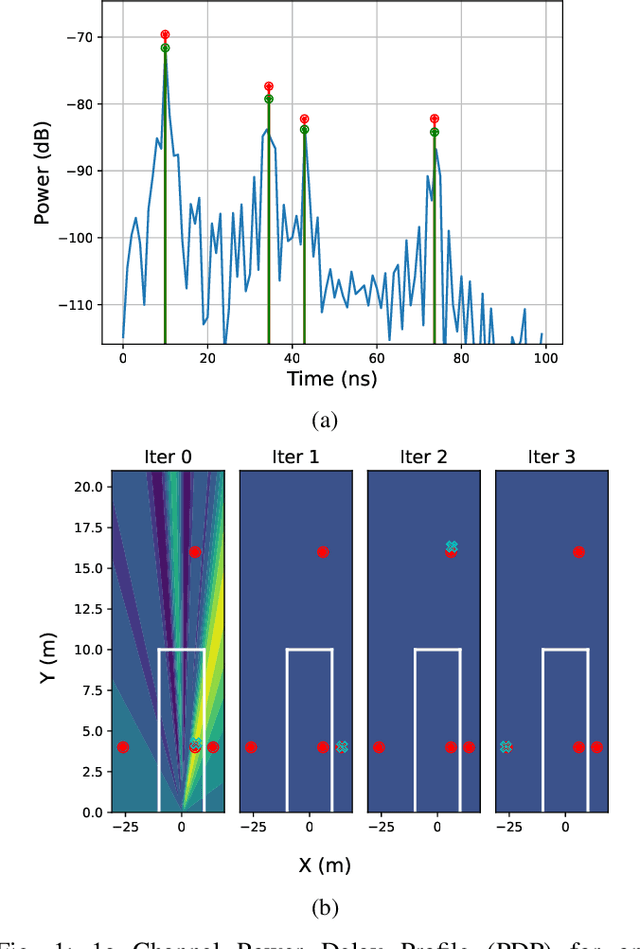

Abstract:The upper mid-band (or FR3, spanning 6-24 GHz) is a crucial frequency range for next-generation mobile networks, offering a favorable balance between coverage and spectrum efficiency. From another perspective, the systems operating in the near-field in both indoor environment and outdoor environments can support line-of-sight multiple input multiple output (MIMO) communications and be beneficial from the FR3 bands. In this paper, a novel method is proposed to measure the near-field parameters leveraging a recently developed reflection model where the near-field paths can be described by their image points. We show that these image points can be accurately estimated via triangulation from multiple measurements with a small number of antennas in each measurement, thus affording a low-cost procedure for near-field multi-path parameter extraction. A preliminary experimental apparatus is presented comprising 2 transmit and 2 receive antennas mounted on a linear track to measure the 2x2 MIMO channel at various displacements. The system uses a recently-developed wideband radio frequency (RF) transceiver board with fast frequency switching, an FPGA for fast baseband processing, and a new parameter extraction method to recover paths and spherical characteristics from the multiple 2x2 measurements.
An Experimental Multi-Band Channel Characterization in the Upper Mid-Band
Nov 19, 2024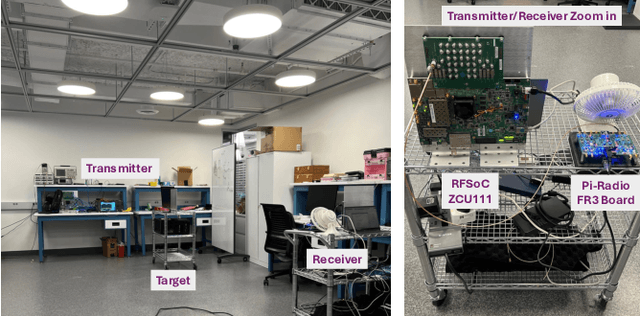
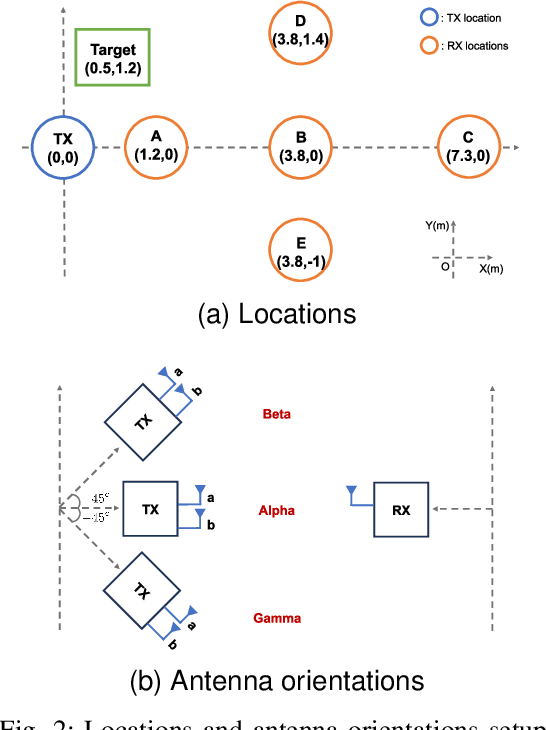
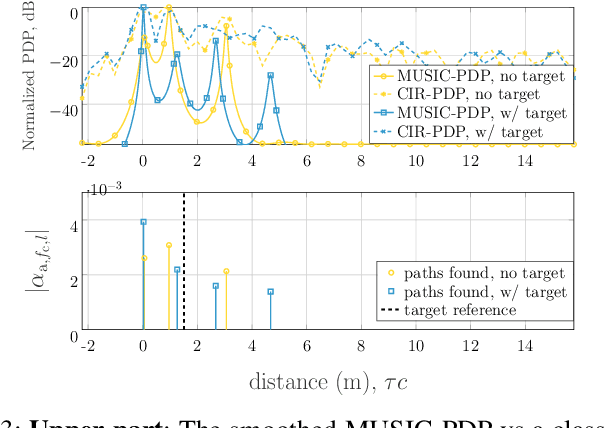

Abstract:The following paper provides a multi-band channel measurement analysis on the frequency range (FR)3. This study focuses on the FR3 low frequencies 6.5 GHz and 8.75 GHz with a setup tailored to the context of integrated sensing and communication (ISAC), where the data are collected with and without the presence of a target. A method based on multiple signal classification (MUSIC) is used to refine the delays of the channel impulse response estimates. The results reveal that the channel at the lower frequency 6.5 GHz has additional distinguishable multipath components in the presence of the target, while the one associated with the higher frequency 8.75 GHz has more blockage. The set of results reported in this paper serves as a benchmark for future multi-band studies in the FR3 spectrum.
Channel Modeling for FR3 Upper Mid-band via Generative Adversarial Networks
Apr 25, 2024Abstract:The upper mid-band (FR3) has been recently attracting interest for new generation of mobile networks, as it provides a promising balance between spectrum availability and coverage, which are inherent limitations of the sub 6GHz and millimeter wave bands, respectively. In order to efficiently design and optimize the network, channel modeling plays a key role since FR3 systems are expected to operate at multiple frequency bands. Data-driven methods, especially generative adversarial networks (GANs), can capture the intricate relationships among data samples, and provide an appropriate tool for FR3 channel modeling. In this work, we present the architecture, link state model, and path generative network of GAN-based FR3 channel modeling. The comparison of our model greatly matches the ray-tracing simulated data.
An Experimental Prototype for Multistatic Asynchronous ISAC
Oct 01, 2023Abstract:We prototype and validate a multistatic mmWave ISAC system based on IEEE802.11ay. Compensation of the clock asynchrony between each TX and RX pair is performed using the sole LoS wireless signal propagation. As a result, our system provides concurrent target tracking and micro-Doppler estimation from multiple points of view, paving the way for practical multistatic data fusion. Our results on human movement sensing, complemented with precise, quantitative GT data, demonstrate the enhanced sensing capabilities of multistatic ISAC, due to the spatial diversity of the receiver nodes.
Cellular Wireless Networks in the Upper Mid-Band
Sep 11, 2023



Abstract:The upper mid-band -- roughly from 7 to 24 GHz -- has attracted considerable recent interest for new cellular services. This frequency range has vastly more spectrum than the highly congested bands below 7 GHz while offering more favorable propagation and coverage than the millimeter wave (mmWave) frequencies. Realizing the full potential of these bands, however, will require fundamental changes to the design of cellular systems. Most importantly, spectrum will likely need to be shared with incumbents including communication satellites, military RADAR, and radio astronomy. Also, due to the wide bandwidth, directional nature of transmission, and intermittent occupancy of incumbents, cellular systems will need to be agile to sense and intelligently use large spatial and bandwidth degrees of freedom. This paper attempts to provide an initial assessment of the feasibility and potential gains of wideband cellular systems operating in the upper mid-band. The study includes: (1) a system study to assess potential gains of multi-band systems in a representative dense urban environment; (2) propagation calculations to assess potential cross interference between satellites and terrestrial cellular services; and (3) design and evaluation of a compact multi-band antenna array structure. Leveraging these preliminary results, we identify potential future research directions to realize next-generation systems in these frequencies.
JUMP: Joint communication and sensing with Unsynchronized transceivers Made Practical
Apr 16, 2023Abstract:Wideband millimeter-wave communication systems can be extended to provide radar-like sensing capabilities on top of data communication, in a cost-effective manner. However, the development of joint communication and sensing technology is hindered by practical challenges, such as occlusions to the line-of-sight path and clock asynchrony between devices. The latter introduces time-varying timing and frequency offsets that prevent the estimation of sensing parameters and, in turn, the use of standard signal processing solutions. Existing approaches cannot be applied to commonly used phased-array receivers, as they build on stringent assumptions about the multipath environment, and are computationally complex. We present JUMP, the first system enabling practical bistatic and asynchronous joint communication and sensing, while achieving accurate target tracking and micro-Doppler extraction in realistic conditions. Our system compensates for the timing offset by exploiting the channel correlation across subsequent packets. Further, it tracks multipath reflections and eliminates frequency offsets by observing the phase of a dynamically-selected static reference path. JUMP has been implemented on a 60 GHz experimental platform, performing extensive evaluations of human motion sensing, including non-line-of-sight scenarios. In our results, JUMP attains comparable tracking performance to a full-duplex monostatic system and similar micro-Doppler quality with respect to a phase-locked bistatic receiver.
Multi-Frequency Channel Modeling for Millimeter Wave and THz Wireless Communication via Generative Adversarial Networks
Dec 22, 2022Abstract:Modern cellular systems rely increasingly on simultaneous communication in multiple discontinuous bands for macro-diversity and increased bandwidth. Multi-frequency communication is particularly crucial in the millimeter wave (mmWave) and Terahertz (THz) frequencies, as these bands are often coupled with lower frequencies for robustness. Evaluation of these systems requires statistical models that can capture the joint distribution of the channel paths across multiple frequencies. This paper presents a general neural network based methodology for training multi-frequency double directional statistical channel models. In the proposed approach, each is described as a multi-clustered set, and a generative adversarial network (GAN) is trained to generate random multi-cluster profiles where the generated cluster data includes the angles and delay of the clusters along with the vectors of random received powers, angular, and delay spread at different frequencies. The model can be readily applied for multi-frequency link or network layer simulation. The methodology is demonstrated on modeling urban micro-cellular links at 28 and 140 GHz trained from extensive ray tracing data. The methodology makes minimal statistical assumptions and experiments show the model can capture interesting statistical relationships between frequencies.
Wireless Channel Prediction in Partially Observed Environments
Jul 03, 2022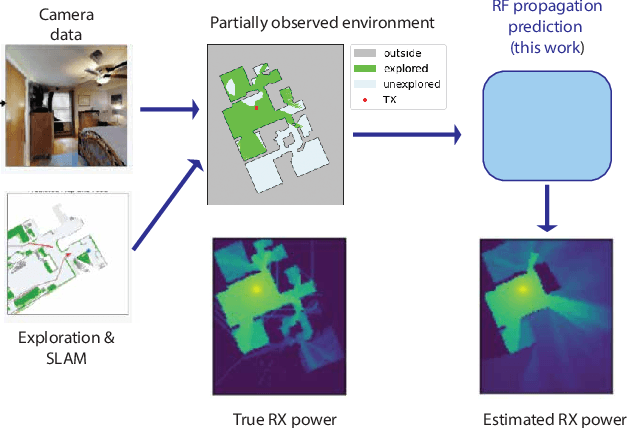

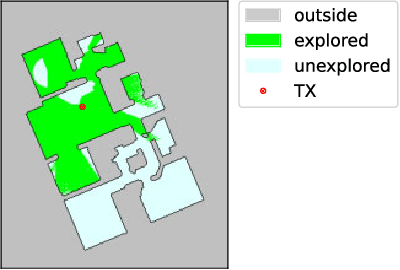

Abstract:Site-specific radio frequency (RF) propagation prediction increasingly relies on models built from visual data such as cameras and LIDAR sensors. When operating in dynamic settings, the environment may only be partially observed. This paper introduces a method to extract statistical channel models, given partial observations of the surrounding environment. We propose a simple heuristic algorithm that performs ray tracing on the partial environment and then uses machine-learning trained predictors to estimate the channel and its uncertainty from features extracted from the partial ray tracing results. It is shown that the proposed method can interpolate between fully statistical models when no partial information is available and fully deterministic models when the environment is completely observed. The method can also capture the degree of uncertainty of the propagation predictions depending on the amount of region that has been explored. The methodology is demonstrated in a robotic navigation application simulated on a set of indoor maps with detailed models constructed using state-of-the-art navigation, simultaneous localization and mapping (SLAM), and computer vision methods.
Parametrization of High-Rank Line-of-Sight MIMO Channels with Reflected Paths
May 11, 2022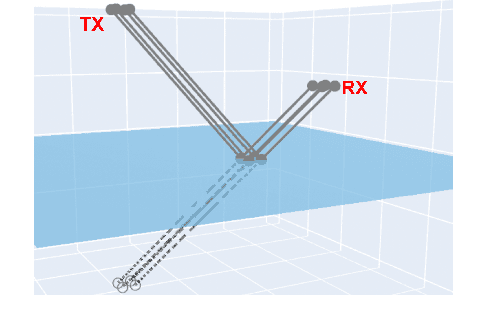
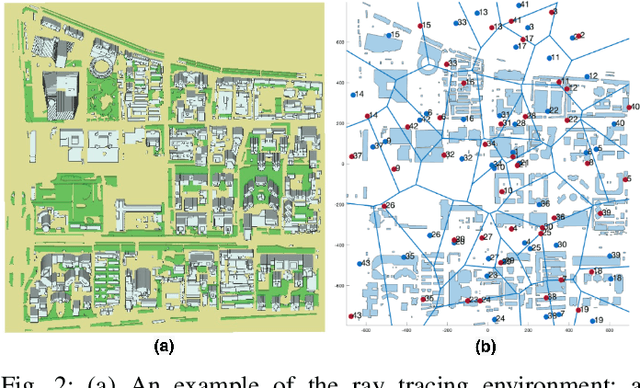
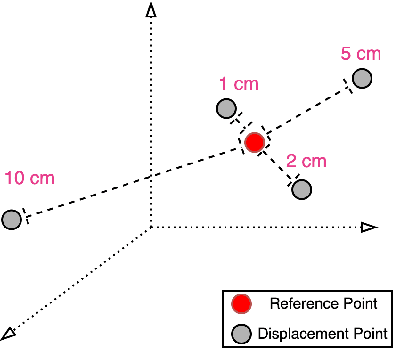
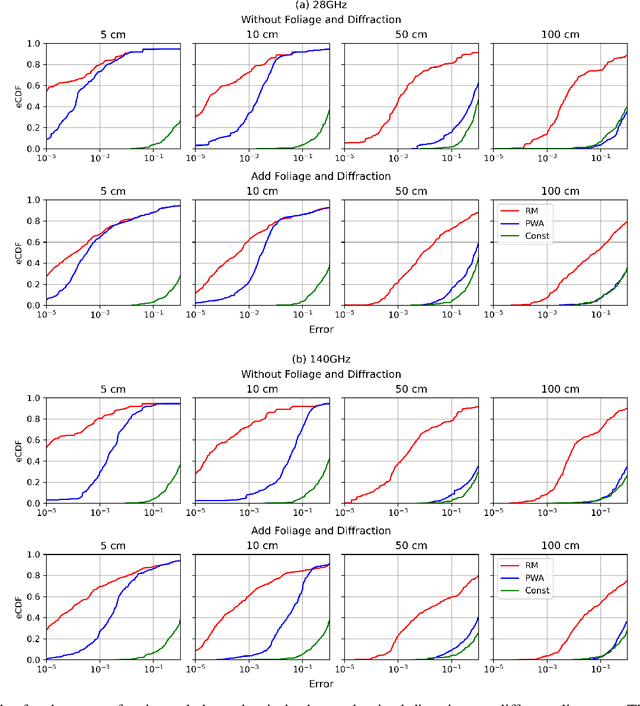
Abstract:High-rank line-of-sight (LOS) MIMO systems have attracted considerable attention for millimeter wave and THz communications. The small wavelengths in these frequencies enable spatial multiplexing with massive data rates at long distances. Such systems are also being considered for multi-path non-LOS (NLOS) environments. In these scenarios, standard channels models based on plane waves cannot capture the curvature of each wave front necessary to model spatial multiplexing. This work presents a novel and simple multi-path wireless channel parametrization where each path is replaced by a LOS path with a reflected image source. The model fully captures the spherical nature of each wave front and uses only two additional parameters relative to the standard plane wave model. Moreover, the parameters can be easily captured in standard ray tracing. The accuracy of the approach is demonstrated on detailed ray tracing simulations at 28GHz and 140GHz in a dense urban area.
 Add to Chrome
Add to Chrome Add to Firefox
Add to Firefox Add to Edge
Add to Edge